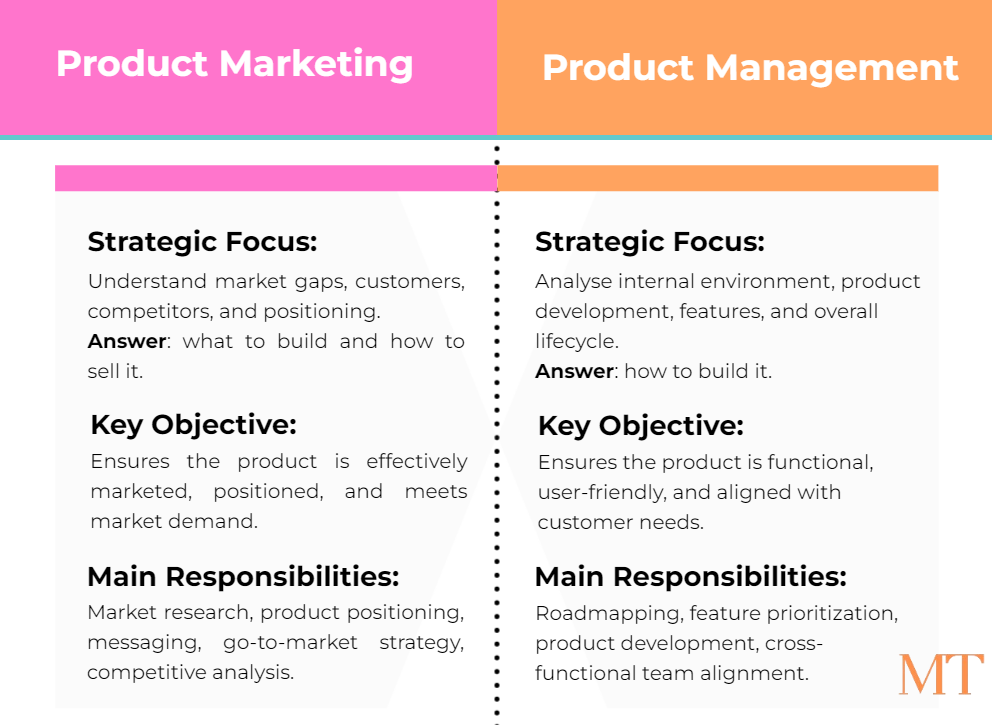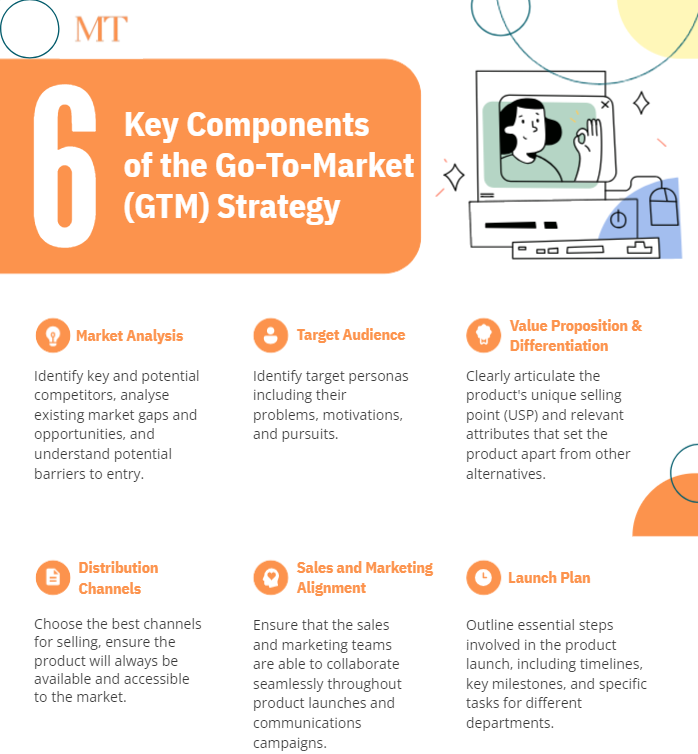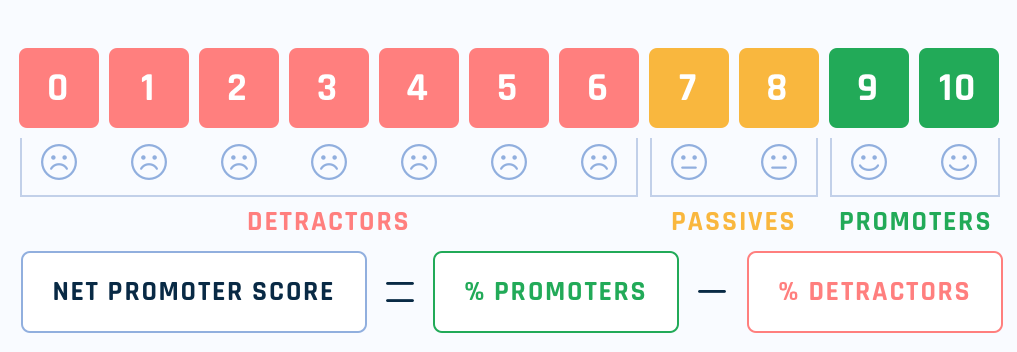Product marketing is the strategic process of identifying a gap in a particular market, bringing a solution to fulfil the gap, promoting it as a must-have asset to the right audience, and eventually helping the firm make profit by meeting the demand as far as possible.
In short, product marketing can be seen at the intersection of R&D, sales, design, and customer relationship management.
The goal of a product marketer in a corporation is to ensure that the product fits a profitable market and resonates with the right people at the right time by looking into its value proposition and how it solves a specific pain point.
As the current market becomes more saturated, product marketing is getting more essential in driving business growth.
A well-executed product marketing strategy aligns teams across sales, product development, and marketing, ensuring that everyone works towards the same goals: product success and customer satisfaction.
Product Marketing in a Nutshell
1. Product Marketing: What it is and isn’t.
At its core, product marketing is about understanding an existing problem in the market and developing a profitable solution to it.
Of course, this process involves crafting messaging that resonates with target customers, building effective go-to-market strategies, and tracking product performance post-launch.
It’s a distinct function that serves as a bridge between the product development team and the sales/marketing teams.
Unlike traditional marketing tasks which cast a wide net, from brand awareness, advertising to sales promotion and public relations; product marketing narrows in on the specific product features, benefits, and solutions offered to a targeted customer persona.
2. The Role of Product Marketers
Product marketers are the unsung heroes who ensure that products launch successfully and also thrive in the marketplace. Their role varies from pre-launch planning to post-launch optimisation. Here’s a closer look at what they do:
- Define Value Proposition: they must be able to clearly articulate the product’s benefits and explain why it matters to the target segment. This includes identifying customer pain points, how the product addresses them in a distinctive way compared to other alternatives.
- Identify Buyer Personas: they are expected to develop detailed buyer personas to help the firm better understand the target audience, including their demographics, behaviours, interests, and motivations.
- Build messaging and positioning strategy: having understood the value proposition, they have to craft thorough core product messaging and positioning plans to help the sales and marketing teams understand who it’s for, and why it’s the best solution for that group.
- Pre-launch planning: before a product launch, they often work with cross-functional teams to prepare for go-to-market strategies.
- Launching: product marketers manage the execution of product launch campaigns, including demos, PR events, content marketing, etc. They have to ensure that the campaigns convey consistent messaging across touchpoints.
- Enable Sales team: they work closely with sales teams to provide the tools they need to sell effectively, such as providing sales training sessions and regularly collecting feedback from salespeople to identify areas for improvement.
- Analyse market and competitors: they are expected to be experts in doing market research and showing agility. Product marketers should always keep themselves updated with the competitive context, emerging trends, and changing customer behaviours; all to help the firm stay agile and competitive.
- Monitor Performance: great marketers should be data-driven. They should have clear KPIs to monitor in mind to further optimise the ongoing campaigns and identify new opportunities for sustainable growth.
3. Product Marketing vs. Product Management

Although the terms are sometimes used interchangeably, they serve different functions within a company.
Product managers focus on building the product, managing its lifecycle, and making decisions about features and development priorities. Their main concern is with the internal aspects of the product, ensuring it meets customer needs from a technical and usability standpoint.
Product marketers, on the other hand, focus on bringing the product to market and ensuring its success in the external environment. While product managers ask, “What should we build?”, product marketers ask, “How do we sell it?”.
Product Marketing Strategy & Framework
A successful product marketing strategy should be always about understanding the target market, aligning internal teams, and delivering value propositions that resonate with customers.
1. Develop Go-To-Market (GTM) Strategies
A Go-To-Market (GTM) strategy is the blueprint for launching a product and bringing it to market successfully.
This strategy outlines how a product will be introduced, marketed, and sold to customers, focusing on maximising market penetration and ensuring that sales, marketing, and product teams are aligned.
A well-defined GTM strategy typically includes:
1. Market Analysis: product marketers always begin their GTM strategies by researching competitors, identifying market gaps and opportunities, and understanding potential barriers to entry. Typical frameworks for market analysis include SWOT for internal auditing, PESTEL for external environment understanding, and Porter’s Five Forces for industry analysis, BCG matrix for product portfolio examination, and so on.
2. Target Audience: product marketers are in charge of identifying the ideal customer by diving deep into personas to learn about their problems, motivations, and pursuits. They represent the customer’s voice within the organisation.
3. Value Proposition & Differentiation: the GTM strategy should clearly articulate the product’s unique selling point (USP) and relevant attributes that set the product apart from the alternatives in the market. Product marketers then leverage this to communicate with the target audience and explain why the product matters to them.
4. Distribution Channels: a good product should always be available and accessible to the market. For that reason, GTM strategies often define the most viable channels for reaching the target personas.
5. Sales and Marketing Alignment: product marketers need to ensure that the sales and marketing teams are able to collaborate seamlessly throughout the campaigns. While marketers provide assets and tailored content to generate qualified leads and drive demand, salespeople have to understand the core messaging and positioning to convert the leads.
6. Launch Plan: the GTM strategy outlines essential steps involved in the product launch, including timelines, key milestones, and specific tasks for different departments. The plan is supposed to help the organisation stay on track and maximise joint efforts.

2. Product Positioning & Messaging
Product positioning is the process of defining how a product should be perceived by the market, and product messaging is how a brand communicates that desired perception to your audience.
- Positioning Statement: an essential task of product marketers involve creating a concise positioning statement for the entire organisation. The statement typically answers the following questions:
– Who is the target audience?
– What key benefits does the product provide?
– What makes the product different from others? - Tailored Messaging for Distinct Personas: product messaging should not be designed to be ‘one-size-fits-all’. Different personas have different needs and pain points. Hence, tailoring the core message helps the brand engage its target persona more effectively.
- Storytelling: by framing the product as the hero in the customer’s story, solving real problems and transforming their experience, brands can create a deeper connection with the audience.
- Consistent Messaging Across Channels: whether it’s your website, social media, email campaigns, or sales calls, the promise that the brand delivers to its target customer should remain consistent and authentic. This consistency reinforces the product’s unique value proposition and gain trust with the audience.
3. Understand Buyer Personas and Customer Journeys
A well-rounded product marketing strategy is built on a deep understanding of the customers. This involves identifying buyer personas, which are detailed profiles of the ideal segment; and mapping out their buying journeys to understand how they discover, consider, and make final decisions.
For example, a SaaS product might have personas such as a “Tech-Savvy CTO” who values product innovation and scalability, or a “Cost-Conscious SMB Owner” who prioritises ease of use and affordability.
Tools And Techniques In Product Marketing
1. Market Research Methodology
As stated above, market analysis is super important in understanding market gaps and positioning a product effectively.
Product marketers always execute their GTM strategy by initially gathering necessary customer insights, analysing the competitive landscape, and investigating potential external factors.
Techniques to gather valuable customer insights include:
- Surveys and Customer Interviews: the most effective way to understand customers is to go and talk with them. These methods provide qualitative and quantitative data about customer pain points, preferences, and expectations.
– Tools: Survey Monkey, Google Forms, and other research agencies. - Social Listening: companies like Hootsuite or Brandwatch allow product marketers to monitor online conversations and trends related to their category or industry. Social listening helps them understand what customers are saying in real-time, providing a pulse on shifting preferences or emerging needs.
- Feedback Loops: develop continuous feedback loops through tools like NPS (Net Promoter Score) or in-app surveys allows product marketers to assess ongoing satisfaction levels, track evolving needs, and make adjustments to both the product and marketing strategies.

2. Sales Enablement Materials
Sales enablement is a must-have function of product marketing. It provides the sales team with the right tools, resources, and training, ensuring that they can clearly communicate the product’s value proposition, address customer objections, and close deals.
- Sales Collateral: Product marketers create various pieces of sales collateral, such as pitch decks, product brochures, and one-pagers that highlight the core benefits of the product.
- Battle Cards: These are short, tactical documents that help sales reps quickly compare the product with competitors. Battle cards include features, pricing, common customer objections, and counterpoints.
- Case Studies: Customer success stories are powerful tools for sales teams. A well-written case study highlights a real-world example of how a product solved a specific challenge for a customer. It provides social proof and demonstrates the product’s value in action.
- Product Training and Demos: Product marketers are responsible for training the sales team on the product’s features, benefits, and use cases. This often involves creating product demo scripts, hosting training sessions, or even running live demo events for potential customers.
Case Studies: Examples of Product Marketing Success
1. Apple’s iPhone Launch
Apple’s iPhone Launch is a perfect example of the meticulous product marketing strategy. The key to Apple’s success lies in the way they anticipated customer needs even before customers were aware of them.
By focusing on simplicity, design, and user experience, Apple positioned the iPhone as a revolutionary device that was more than just a phone. Their creative marketing campaigns focused on how the product enhances daily life, rather than highlighting technical specs.
2. Slack’s Bottom-Up Adoption
When Slack launched, instead of targeting executives or IT departments, they focused on individual teams within organisations. This bottom-up product marketing strategy encouraged teams to adopt the product, eventually leading to full company-wide adoption.
Also, Slack’s focus on customer feedback and iterative improvements helped them create a product that was user-friendly and solved real communication problems within companies.
3. Dropbox’s Referral Program
Dropbox’s growth was significantly boosted by its referral marketing strategy. They incentivised users to invite friends by offering extra storage space for every successful referral. This simple yet effective strategy turned existing customers into advocates, driving exponential growth at a low customer acquisition cost.
Measuring Product Marketing Success
1. KPIs for Product Marketing
- Customer Acquisition Cost (CAC): This metric measures the cost of acquiring a new customer. By calculating CAC, marketers can determine the efficiency of their campaigns and find ways to optimise their spending. Lowering CAC while maintaining customer growth is often a key objective.
- Customer Lifetime Value (CLV): CLV estimates the total revenue a customer will generate over the entire course of their relationship with a business. By comparing CLV to CAC, product marketers can assess the return on investment (ROI) of their customer acquisition strategies.
- Conversion Rate: Conversion rate measures the percentage of leads or prospects that take a desired action, such as signing up for a demo or making a purchase. It provides insights into how well a marketing campaign is resonating with its target audience.
- Net Promoter Score (NPS): NPS is a simple but important tool for gauging customer loyalty. By asking customers how likely they are to recommend a product, marketers can gain insights into overall customer satisfaction and identify areas for improvement.
- Product Adoption Rate: This measures the percentage of customers who adopt and regularly use the product after purchasing it. High adoption rates indicate that users are finding value in the product, while low rates may signal issues with onboarding or usability.
- Churn Rate: Churn measures the percentage of customers who stop using the product over a specific time period. Reducing churn is crucial for maintaining a healthy and loyal customer base.
2. Tools for Tracking Metrics
Product marketers have access to a wide range of tools that help track these KPIs and provide valuable insights into campaign performance:
- Google Analytics: Google Analytics is widely used to track website traffic, user behavior, and conversion goals. Product marketers can set up custom reports to track key product-related metrics, such as acquisition and conversion rates.
- HubSpot: HubSpot’s marketing automation platform includes tools for tracking everything from email performance to customer acquisition. It provides a comprehensive view of customer interactions across multiple touchpoints.
- Salesforce: As a CRM platform, Salesforce tracks customer data and sales pipeline performance, helping product marketers analyse customer journeys and measure conversion rates.
- Mixpanel: Mixpanel is a powerful tool for tracking product usage and user behaviour. It allows product marketers to see how customers interact with specific features and identify patterns that can help improve product adoption.
- Hotjar: Hotjar provides heatmaps, session recordings, and user surveys to understand how users are interacting with your product or website. These insights can help marketers pinpoint usability issues and areas for improvement.
3. How To Pivot Product Marketing Strategy
Product marketers are expected to be adaptable, meaning that they have to get ready to pivot their strategies when urgent to better meet customer needs.
- Customer Feedback Loops: Gathering continuous feedback from customers allows product marketers to make incremental adjustments. For example, introducing new features based on user suggestions or addressing recurring complaints can greatly improve product satisfaction.
- A/B Testing: A/B testing allows marketers to experiment with different messaging, CTAs (Call to Action), and marketing channels. By analysing the performance of various test versions, product marketers can determine what resonates best with their target audience.
- Iterating on Product Positioning: If market conditions change or a competitor introduces a disruptive product, it may be necessary to refine the product’s positioning. This could involve changing how the product is marketed, the audience it targets, or even adjusting its pricing model to maintain competitive advantage.
- Revamping Go-To-Market (GTM) Strategy: If product adoption is lower than expected, marketers may need to revise the GTM strategy. This might involve exploring new marketing channels, refining buyer personas, or adjusting pricing and promotions.
Final Thought: How to become a product marketer
1. Build a Strong Foundation in Marketing Principles
To begin our journey in product marketing, it’s important for young marketers to fully comprehend all essential marketing concepts. Hence, reading classics like “Principles of Marketing” by Philip Kotler will provide us with a comprehensive understanding of marketing fundamentals. For a more hands-on learning experience, platforms like Google Digital Garage and Coursera offer free and paid certifications in digital marketing. Courses like HubSpot’s Inbound Marketing Certification introduce crucial marketing concepts and strategies.
2. Learn to Conduct Market Research
Practical skills in market research are also a must in product management. Tools like Google Analytics and SEMrush can help us practice data interpretation by analysing real-time market trends. To dive deeper, we can take courses such as “Market Research and Consumer Behavior” on Coursera, offered by IE Business School, which covers the principles of market research. Books like “Marketing Research: An Applied Orientation” by Naresh Malhotra offer further insights into research techniques.
3. Gain Cross-Functional Experience
For students seeking hands-on experience, internships and volunteer projects are a great way to work across sales, product, and customer service teams. Websites like LinkedIn Learning provide courses that teach cross-functional communication skills. It’s highly recommended that we should look for real-world opportunities through platforms like Handshake or LinkedIn Jobs where internships in product marketing are frequently posted.
4. Stay Updated with Industry Trends
Staying current with trends is crucial. Students can follow blogs like Product Marketing Alliance, HubSpot, or Mind the Product for regular updates on industry shifts. Additionally, attending virtual conferences and events, such as PMM Summit or ProductCamp, helps them stay connected with industry leaders and emerging trends in product marketing.
5. Practice Messaging and Storytelling
Mastering product messaging can begin with practicing storytelling. For students, platforms like StoryBrand offer resources on how to craft clear, compelling messages. Additionally, writing practice through blogs or case studies can be strengthened with courses on Udemy such as “Copywriting: Writing to Sell.” Internships or freelance work for small startups offer practical opportunities to develop these critical skills while contributing to real product marketing projects.
Sy Chu
As an analytical and creative marketing enthusiast skilled in customer analysis, content research and brand management, my passion is help businesses gain insights into their brand and marketing strategies to drive impactful outcome to their success.
